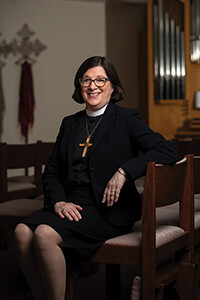We are the branches
August 3, 2018
Is it possible to be Lutheran and an ecumenist? Of course, the answer is yes. The ELCA has continued the work of our predecessor churches—the Association of Evangelical Lutheran Churches, the American Lutheran Church, and the Lutheran Church in America—all of which engaged in dialogues with other denominations. When the ELCA was born, its DNA included the will toward unity. The 1991 Churchwide Assembly adopted “A Declaration of Ecumenical Commitment: A Policy Statement of the ELCA”—we were barely 4 years old.
Where did this impulse come from and why is it so deeply important to us?
We have just marked the 500th anniversary of the Reformation. We were a little restrained about celebrating because division in the church is nothing about which to rejoice. (Though when explaining this sensibility to a Roman Catholic colleague and dialogue partner, he did say the reformers’ insistence on the primacy of the gospel is something to be celebrated.) It was never Martin Luther’s intention to divide the church. Loathing the thought that this new movement should be called “Lutheran,” he wrote: “How should I, a poor stinking bag of worms, become so that the children of Christ are named by my unholy name?”
The intent of Luther and the reformers was to give the gospel free course in the world, to make the evangelical case that it is God’s good and gracious will to reconcile the world to God’s self, and that this has been accomplished through the death and resurrection of Jesus Christ apart from any human effort.
Early on, in 1530, the Augsburg Confession not only clarified and defended the evangelical position of the Reformation but made it clear that the reformers’ work was consistent with the one, holy, catholic and apostolic church. (You should all study the confession. I know of congregations that have read and studied this and all the Lutheran Confessions found in the Book of Concord. Ask your pastor.)
This wasn’t a departure from the Christian tradition, nor a break with the church. The Seventh Article of the Augsburg Confession laid out the basis and the possibility for church unity and a variety of expressions of how the gospel could be communicated: “For the true unity of the church it is enough to agree concerning the teaching of the gospel and the administration of the sacraments.”
We all are not only connected to the same vine, but we have no life apart from that vine.
But this is really Christ’s intention and the reality that we have in him. Jesus said, “I am the vine, you are the branches” (John 15:5). We all are not only connected to the same vine, but we have no life apart from that vine. In Holy Communion, we live Christ’s current and our future reality that we are already one. The ELCA humbly tries to embody this truth in the six full-communion partnerships we already have with the Presbyterian Church (U.S.A.), the Reformed Church in America, the United Church of Christ, the Episcopal Church, the Moravian Church, and the United Methodist Church.
We are scripturally, confessionally and even constitutionally wired to be an ecumenical church. This month’s cover story highlights the ecumenical ministries of congregations and the work of ELCA Ecumenical and Interreligious Relations. It is possible to be Lutheran and an ecumenist.
But let me pose this—it is not possible for Lutherans to be ecumenists if we are not Lutheran. This might sound counterintuitive, but I believe it is true. If we aren’t clear and conversant about the Lutheran movement’s way of telling the Jesus story, if we are not clear about the grace that sets us free, if we waffle on the conviction that the reconciliation and redemption of the world is God’s work and not ours, how can we enter into dialogue and relationship with other branches of the Christian tradition?
I called on us to read the Small Catechism during 2017. If you have put your copy away, dust it off and start studying.
The bishop’s email address: bishop@elca.org.

